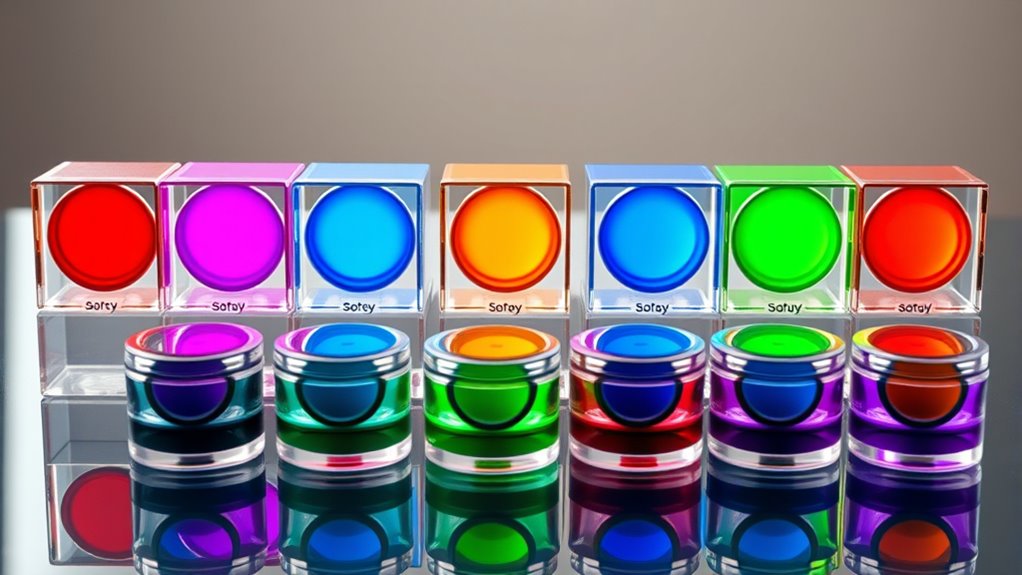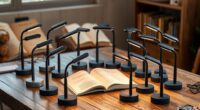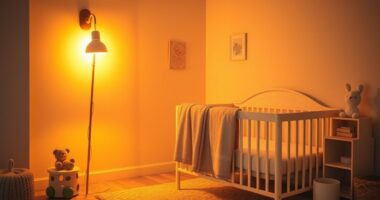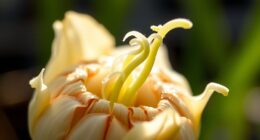If you’re looking for the best hue-test color vision kits, I recommend options like the Farnsworth Munsell 100 Hue Test for detailed analysis and Ishihara booklets with 38 or 14 plates for quick screening. These kits offer reliable results for detecting color deficiencies, are easy to use, and meet industry standards. To find the perfect fit for your needs, and learn about features and benefits, keep exploring further.
Key Takeaways
- The Farnsworth Munsell 100 Hue Test offers detailed hue differentiation with software analysis for precise color accuracy assessment.
- Ishihara Test Booklets feature quick, reliable plates for detecting red-green color deficiencies suitable for clinical and personal use.
- Variants like the Grafco and 24-plate Ishihara kits provide specialized testing for different types and severities of color vision issues.
- These kits are portable, user-friendly, and validated for accurate screening in professional and home environments.
- Selecting reputable kits with standardized procedures ensures reliable results for checking your color discrimination accuracy.
Farnsworth Munsell 100 Hue Test | Color Vision Analysis Tool | Pantone
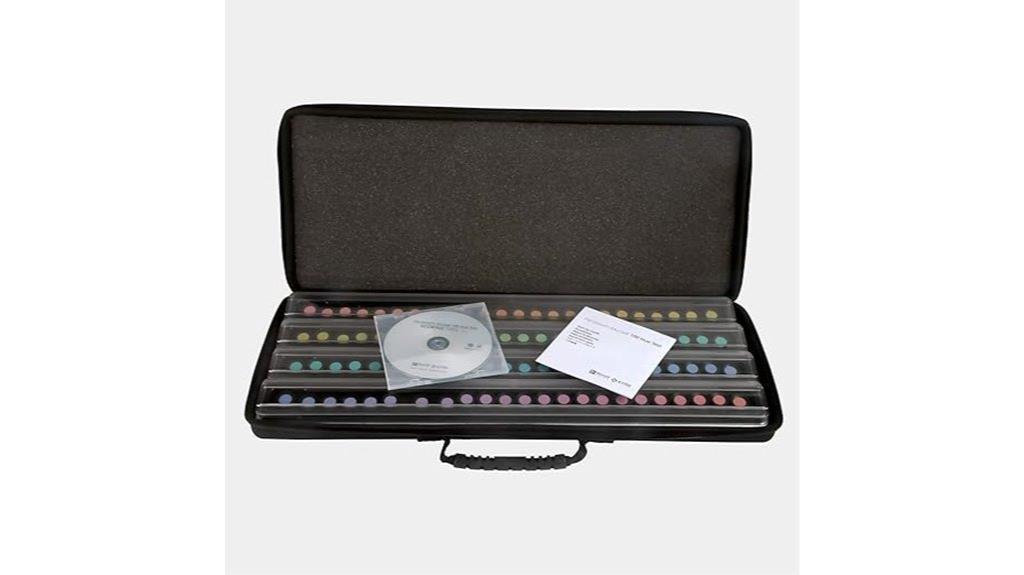
If you’re looking for a reliable way to assess color vision accuracy, the Farnsworth Munsell 100 Hue Test is an excellent choice, especially for professionals who need precise results. I’ve used it to evaluate color perception in various settings, and it’s straightforward and effective. The test includes four trays with 85 color caps, arranged in subtle hue differences across the spectrum. Its software helps analyze results quickly, highlighting any deficiencies or color blindness. It’s a trusted industry standard for over 60 years, ensuring you get accurate insights into an individual’s color discrimination skills for job placement or quality control.
Best For: professionals in industries such as design, manufacturing, and quality control who need a precise and reliable assessment of their or their employees’ color vision capabilities.
Pros:
- Industry-standard tool with over 60 years of trusted use
- Includes comprehensive software for quick analysis and interpretation
- Easy-to-use with removable color caps for subtle hue differentiation
Cons:
- May require careful handling to ensure caps are not misplaced or damaged
- The physical components and software may involve a higher initial cost
- Not suitable for diagnosing specific medical conditions without additional testing
Ishihara Test Chart Books for Color Blindness (38 Plates)

The Ishihara Test Chart Books for Color Blindness with 38 plates is an excellent choice for professionals and individuals seeking a reliable, easy-to-use tool for detecting color vision deficiencies. Released in the 2018 edition, it includes a user manual and an eye occluder, making testing straightforward. Manufactured in Japan by Kanehara, it’s built from durable plastic and comes in a pack of two units. With a customer rating of 4.6 stars from 260 reviews, it’s trusted by many. Its compact design and clear instructions make it suitable for clinics, schools, or home use, providing an efficient way to identify color blindness quickly and accurately.
Best For: professionals, educators, and individuals seeking an accurate, easy-to-use tool for detecting color vision deficiencies at clinics, schools, or home.
Pros:
- Includes comprehensive features like a user manual and eye occluder for straightforward testing.
- Durable plastic construction ensures longevity and repeated use.
- Highly rated with 4.6 stars from 260 reviews, indicating strong customer satisfaction.
Cons:
- Dimensions (18 x 15 x 12 inches) may be larger than necessary for some storage spaces.
- The product is made in Japan, which might affect shipping times or availability in certain regions.
- As a specialized testing tool, it may require some basic training to administer effectively.
Ishihara Test Chart Books, for Color Deficiency
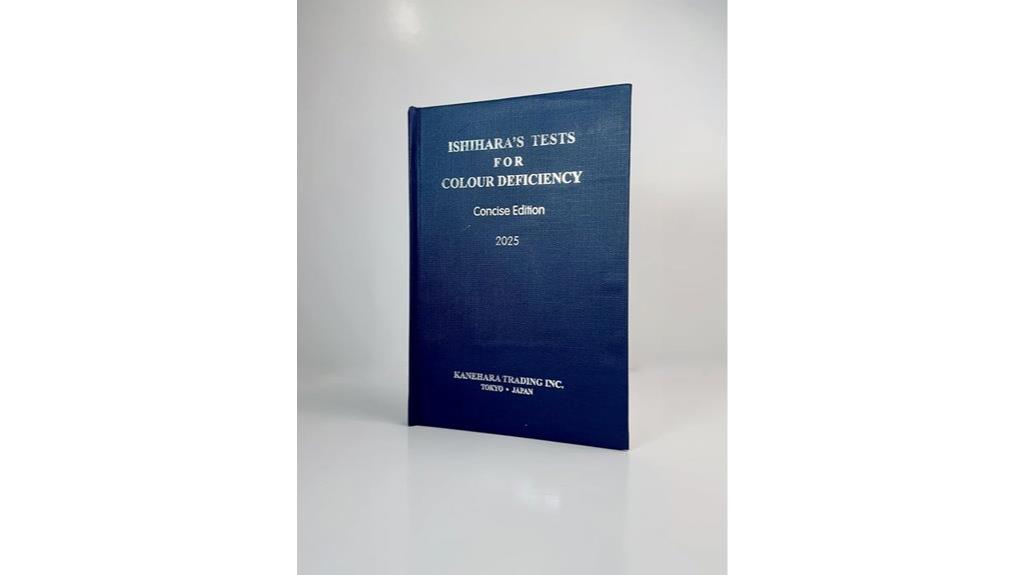
For professionals and individuals needing precise color vision assessment, the Ishihara Test Chart Books offer a reliable solution. The Grafco Ishihara Test Chart Book includes four specially designed plates that help determine both the type and severity of color deficiencies. These plates are specifically created to assess color deficiency accurately, making them a valuable tool for diagnosing and understanding color vision issues. Please note that images may not always reflect the actual product, so it’s important to review the product description carefully. The product code for this testing book is GHF1254, ensuring you get a trusted, well-designed assessment tool.
Best For: Professionals and individuals seeking accurate assessment of color vision deficiencies to diagnose and understand their color vision issues.
Pros:
- Contains four specially designed plates for precise testing
- Helps identify both the type and severity of color deficiency
- Suitable for clinical and personal use to ensure reliable results
Cons:
- May not reflect the actual product images shown online
- Limited to four plates, which might not cover all types of color vision issues
- Requires careful reading of the description to ensure proper use and understanding
ISHIHARA Color Vision Test Book with 38 Plate with User Manual
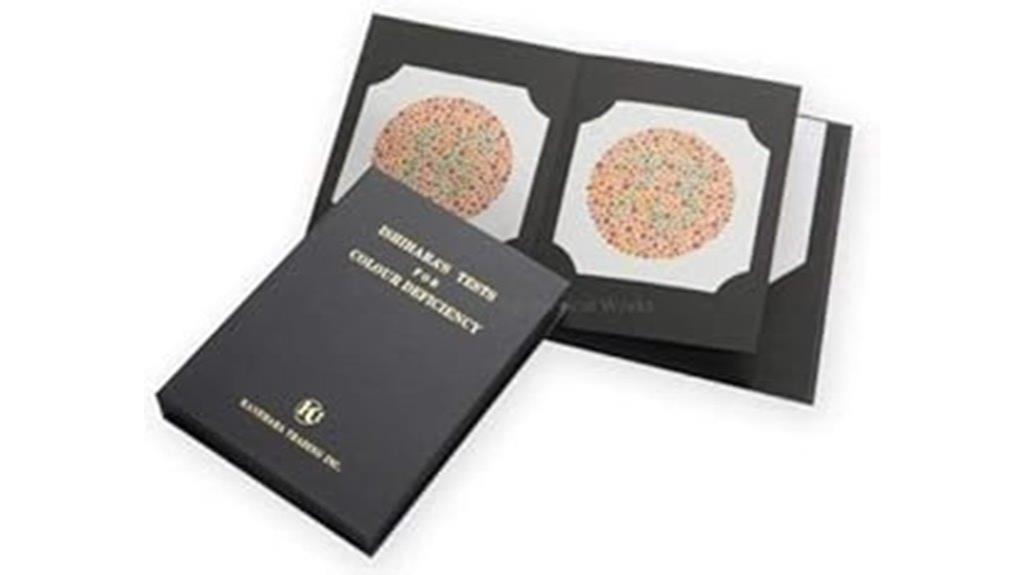
Designed for clinicians and individuals seeking accurate color vision evaluation, the Ishihara Color Vision Test Book with 38 plates offers a thorough and reliable screening tool. It features four test design types: vanishing, transformation, hidden digit, and classification, each targeting specific color deficiencies. These designs help detect and differentiate red- and green-blindness, making it a versatile resource for diagnosis. The included user manual guides proper administration, ensuring precise results. Whether for clinical use or personal screening, this book provides a trusted method to identify color vision impairments effectively and efficiently. It’s a practical choice for anyone serious about assessing color accuracy.
Best For: clinicians and individuals seeking a comprehensive, accurate, and easy-to-administer color vision screening tool.
Pros:
- Offers four distinct test design types to identify various color deficiencies.
- Includes a detailed user manual for precise administration.
- Suitable for both clinical and personal use, ensuring versatility.
Cons:
- Requires proper lighting conditions for accurate results.
- May be less effective for very young children or individuals with severe visual impairments.
- Limited to the 38 plates included; additional testing may be necessary for comprehensive diagnosis.
Ishihara Colour Vision Test Book for Color Deficiency
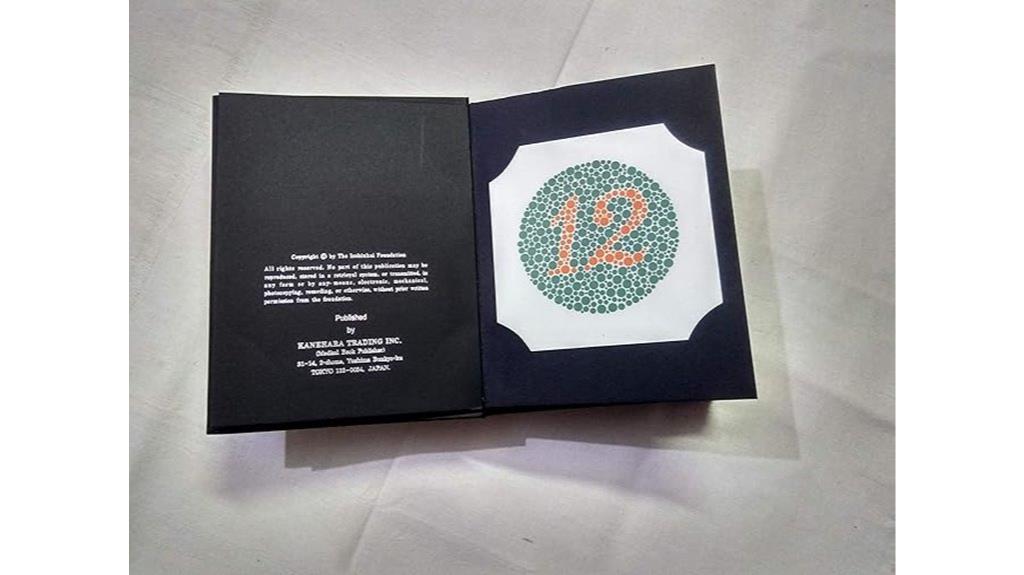
If you’re looking to accurately identify color vision deficiencies, the Ishihara Colour Vision Test Book is an essential tool, especially for professionals and clinics. It features 24 plates designed to reveal red-green color deficits by showing patterns that appear differently to those with normal versus defective vision. The plates exploit how blue and yellow colors seem brighter compared to red and green in color-deficient individuals. The test includes a user manual to ensure proper administration and interpretation. This reliable tool helps diagnose specific types of color blindness effectively, making it ideal for clinical settings or anyone seeking precise color vision assessment.
Best For: professionals, clinicians, and individuals seeking accurate diagnosis of color vision deficiencies in clinical or educational settings.
Pros:
- Utilizes 24 carefully designed plates to reliably detect red-green color deficits.
- Includes a user manual for correct administration and interpretation of results.
- Exploits specific color brightness differences to accurately identify various types of color blindness.
Cons:
- Limited to detecting primarily red-green deficiencies; may not identify all types of color vision issues.
- Requires proper lighting conditions for accurate results, which might limit use in suboptimal environments.
- As a physical book, it may be less convenient for digital or remote testing needs.
Ishihara 38 Plate Color Vision Test Book (2024 Edition)
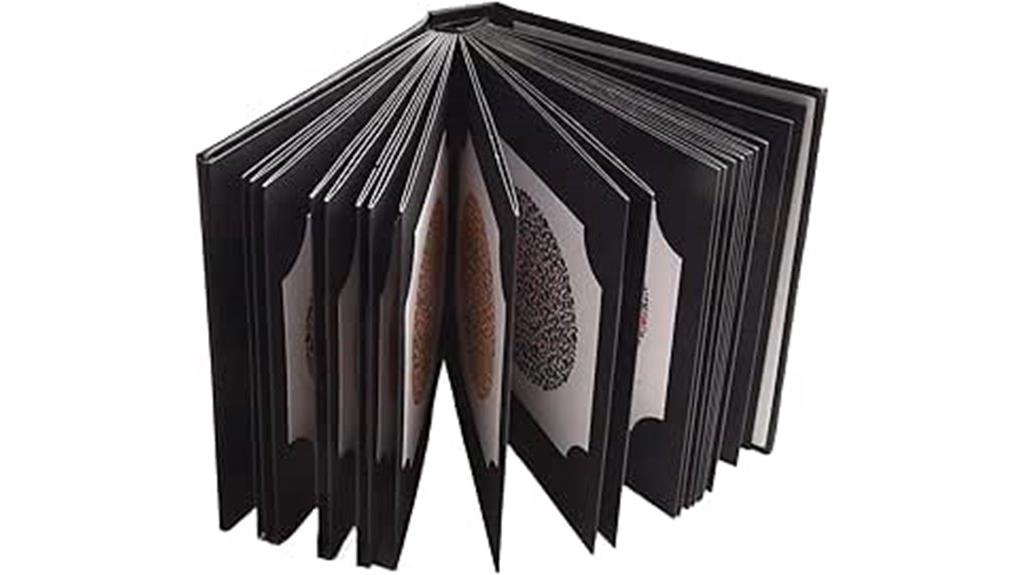
The Ishihara 38 Plate Color Vision Test Book (2024 Edition) is an ideal choice for eye care professionals and individuals seeking accurate screening for red-green color blindness. It features 38 carefully designed plates that diagnose both congenital and acquired color deficiencies. The test includes four distinct plates for detailed evaluation of various types and severities of color vision issues. Its album format guarantees easy handling and seamless testing, whether at home or in a clinical setting. Plus, it promotes awareness and understanding of color perception differences, making it a valuable tool for both diagnosis and education. This edition offers a reliable, user-friendly way to assess color vision accuracy.
Best For: eye care professionals, educators, and individuals seeking an accurate, user-friendly screening tool for red-green color blindness detection.
Pros:
- Contains 38 carefully crafted plates for comprehensive color vision assessment
- Album format facilitates easy handling and testing in various settings
- Promotes awareness and understanding of color perception differences
Cons:
- May require verification of sizing measurements for proper fit
- Focused primarily on red-green color deficiencies, not suitable for all color vision issues
- As a manual screening tool, it cannot replace professional diagnosis or advanced testing
Ishihara Color Vision Test Book 14 Plates with User Manual
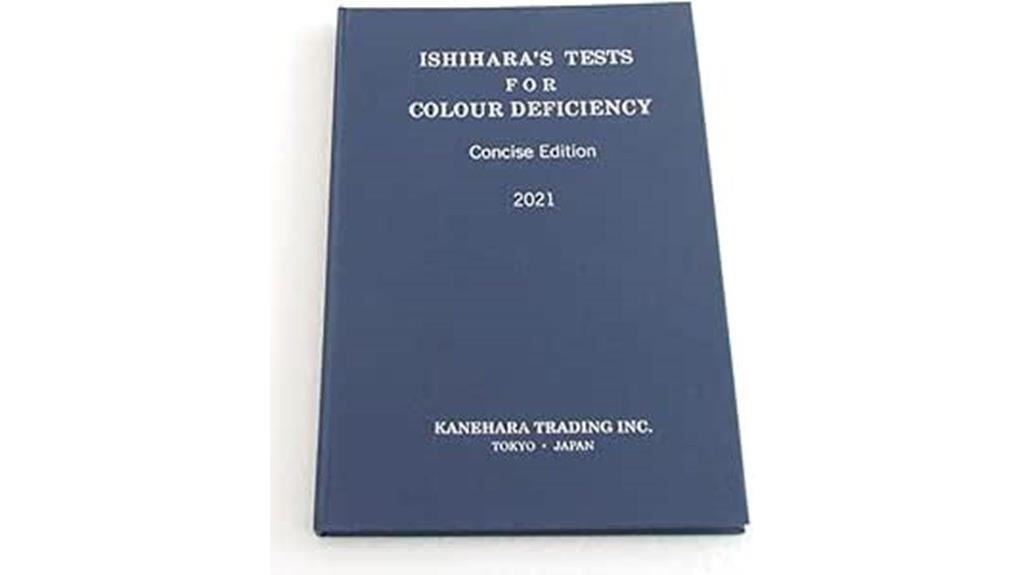
The Ishihara Color Vision Test Book 14 Plates with User Manual is the ideal choice for healthcare professionals and educators seeking a quick, reliable way to screen for color vision deficiencies. This concise edition features 14 well-designed plates that evaluate general color vision and include four special plates to identify specific types and severity of defects. The accompanying manual provides clear instructions, ensuring proper administration and accurate interpretation. Its compact format makes it portable and easy to use in various settings. Overall, this test book offers a trusted, straightforward tool for efficient color vision screening and diagnosis.
Best For: healthcare professionals and educators seeking a reliable, quick, and portable tool for screening and diagnosing color vision deficiencies.
Pros:
- Includes 14 well-designed plates with specific tests for various color vision issues
- Comes with a user manual for proper administration and accurate interpretation
- Compact and portable format suitable for use in multiple settings
Cons:
- Limited to basic screening; may not replace comprehensive ophthalmological assessments
- Only includes 14 plates, which might be less comprehensive than larger test sets
- Requires proper training to ensure correct administration and result interpretation
Ishihara Colour Vision Test Book for Color Deficiency
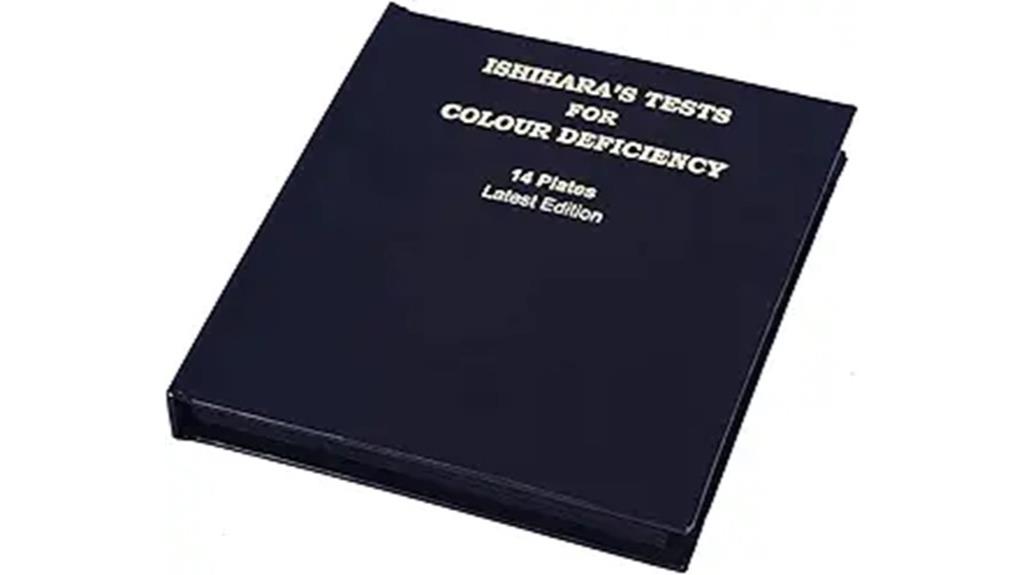
Designed specifically for quick and accurate screening of red-green color deficiencies, the Ishihara Colour Vision Test Book is ideal for clinics, schools, and eye care professionals. It features 14 plates, each with colored dot circles forming numbers or figures visible to those with normal vision but difficult for those with color deficiencies. The test quickly identifies red-green color blindness, as some plates reveal diagnostic patterns to determine the specific type of deficiency. With a user manual included, this compact and effective tool helps professionals efficiently screen and classify color vision issues, making it a valuable resource for early detection and diagnosis.
Best For: clinics, schools, and eye care professionals seeking a quick, reliable screening tool for detecting red-green color vision deficiencies.
Pros:
- Easy to administer and interpret with a clear user manual included
- Compact and portable, suitable for various settings
- Effectively identifies and classifies red-green color deficiencies early
Cons:
- Limited to screening for red-green color blindness and may not detect other color vision issues
- Only contains 14 plates in the standard version, which may provide less detailed information than full versions
- Requires proper lighting conditions for accurate results
ISHIHARA Color Vision Test Book with 24 Plate with User Manual Occluder
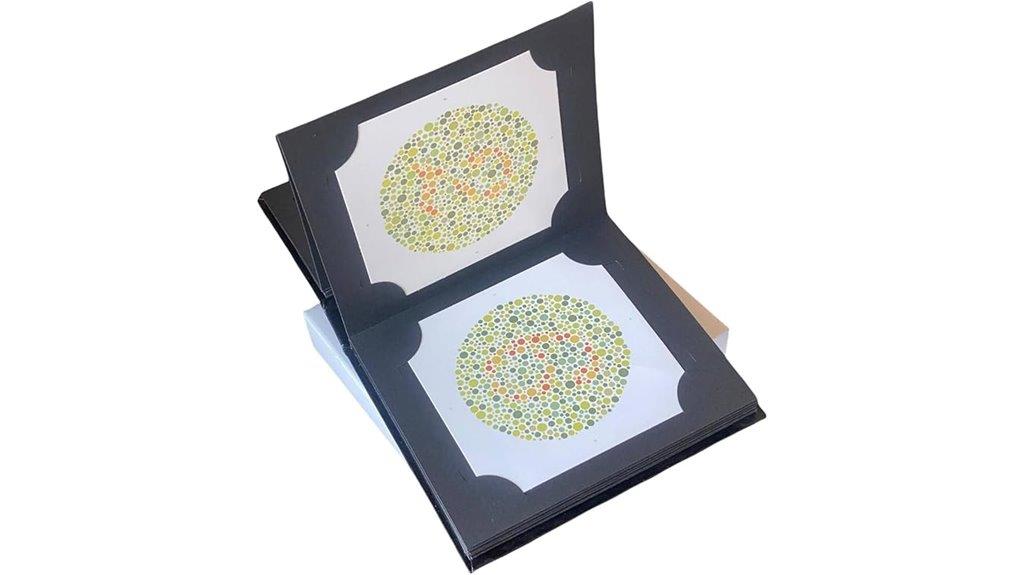
If you’re looking for a reliable and widely recognized tool to screen for color vision deficiencies, the Ishihara Color Vision Test Book with 24 plates is an excellent choice. Created by Dr. Shinobu Ishihara in 1917, it remains the most popular color blindness test worldwide due to its affordability and proven accuracy. The set includes plates with various designs to detect red-green deficiencies, along with a user manual and occluder for proper testing. This simple, effective tool is used by professionals to identify color vision issues quickly. Despite newer methods, its long-standing reputation keeps it a trusted choice for initial screening.
Best For: individuals seeking an affordable, reliable screening tool for detecting red-green color vision deficiencies in clinical or personal settings.
Pros:
- Widely recognized and proven effective for initial screening of color blindness.
- Includes a comprehensive set of 24 plates, user manual, and occluder for accurate testing.
- Cost-effective and easy to use, suitable for professionals and non-professionals alike.
Cons:
- May be challenging for some individuals with normal color vision to interpret the plates correctly.
- Not a definitive diagnostic tool, requiring professional evaluation for conclusive results.
- Design and content may vary slightly due to manufacturer modifications, potentially affecting consistency.
ISHIHARA Color Vision Test Book with 14 Plate with User Manual Occluder
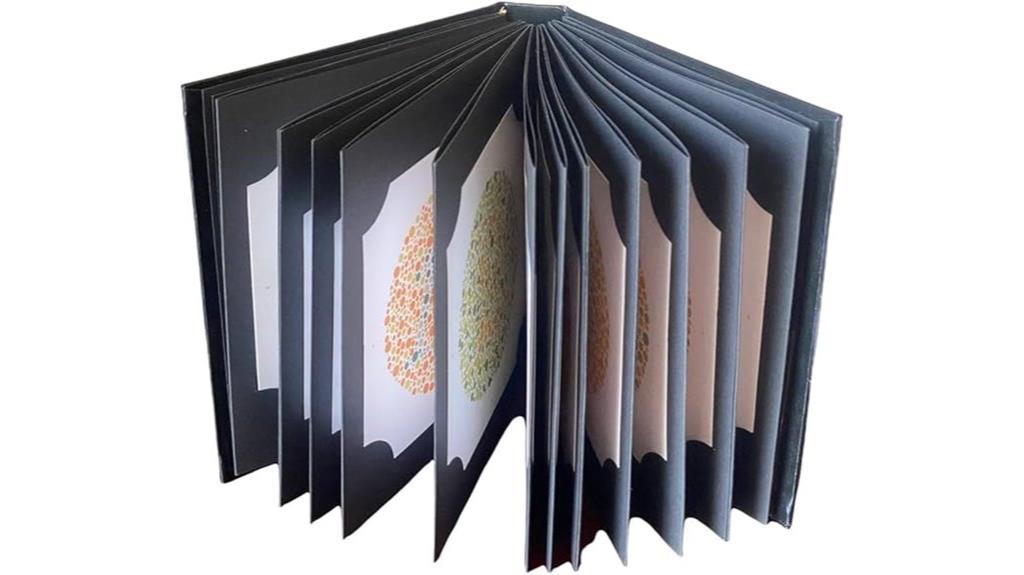
Anyone suspecting they have a color vision deficiency will find the Ishihara Color Vision Test Book with 14 plates an essential tool, especially since it includes a user manual and occluder for easy use. This compact kit offers a quick and effective way to assess color vision, featuring plates designed to reveal different types of deficiencies. The vanishing, transformation, hidden digit, and classification designs help identify whether someone is red- or green-blind, or has other color vision issues. The included occluder makes it simple to cover each plate, ensuring an accurate test. It’s an accessible, straightforward tool for personal or professional use.
Best For: individuals suspecting they have a color vision deficiency, eye care professionals, and anyone needing a quick and reliable color vision assessment tool.
Pros:
- Includes 14 plates with diverse designs to accurately identify different types of color blindness
- Comes with a user manual and occluder for easy, straightforward testing at home or in a clinic
- Compact and portable, making it convenient for personal or professional use
Cons:
- May not detect all rare or subtle color vision deficiencies
- Requires proper understanding of test instructions for accurate results
- Limited to the 14 plates included; additional testing may be necessary for comprehensive diagnosis
Ishihara Color Vision Test Book 24 Plates with User Manual
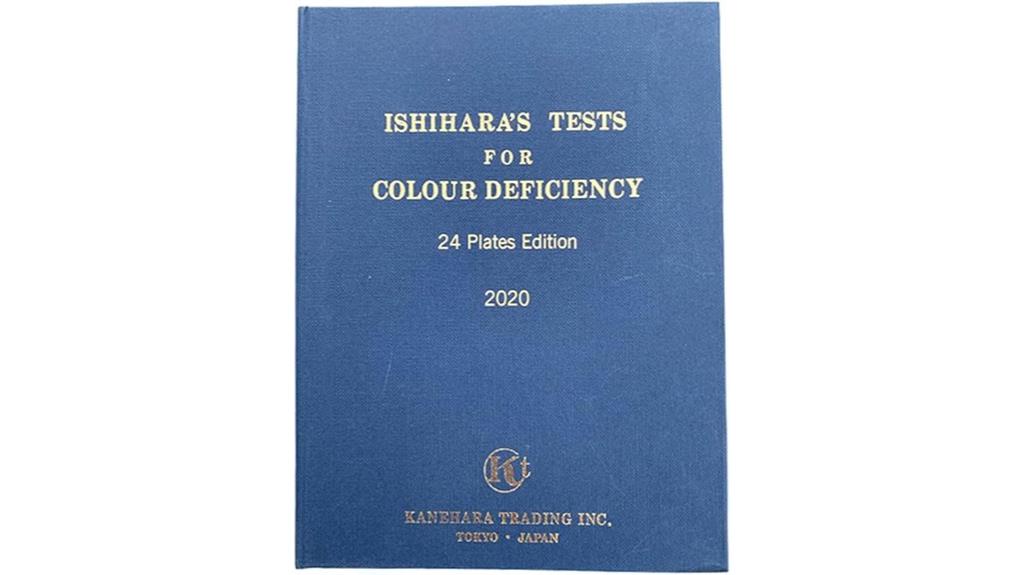
The Ishihara Color Vision Test Book 24 Plates with User Manual is an excellent choice for professionals and individuals seeking an accurate, easy-to-use tool for color vision screening. It includes 24 plates, with four special plates for detailed testing, helping identify various deficiencies like protanopia, deuteranopia, and tritanopia. The clear user manual guides proper administration, ensuring reliable results. Its compact format makes it convenient for clinical use or personal assessment at home. Recognized in ophthalmology and optometry, this test book offers a trusted, straightforward way to evaluate color vision accuracy quickly and effectively.
Best For: professionals in ophthalmology and optometry, individuals conducting personal eye assessments, and educators needing a reliable color vision screening tool.
Pros:
- Includes 24 plates with four special plates for comprehensive testing
- Comes with a clear user manual for accurate administration
- Compact and portable design suitable for clinical or home use
Cons:
- May require some training for optimal administration
- Limited to standard plates; advanced or digital testing may be necessary for detailed analysis
- Not suitable for diagnosing specific types of color vision deficiencies beyond screening
Ishihara Color Test Book (14 Plates, 2024 Edition)

The Ishihara Color Test Book (14 Plates, 2024 Edition) is an excellent choice for healthcare professionals, educators, or individuals who want a quick and reliable method to assess color vision deficiencies. It features 14 carefully designed plates that detect red-green and blue-yellow color blindness. Compact and portable, measuring about 6 x 4 inches, it’s perfect for on-the-go testing. Clear instructions ensure accurate administration and interpretation. Developed by Dr. Shinobu Ishihara in 1917, it remains a trusted diagnostic tool. This concise edition provides standardized results, making it easy to identify color perception issues reliably in various settings.
Best For: healthcare professionals, educators, and individuals seeking a quick, reliable assessment of color vision deficiencies in various settings.
Pros:
- Reliable and standardized results for detecting red-green and blue-yellow color blindness
- Compact, portable design ideal for on-the-go testing
- Clear instructions for easy administration and accurate interpretation
Cons:
- Limited to 14 plates, which may not cover the full spectrum of color vision deficiencies
- Requires proper lighting conditions for optimal accuracy
- Not suitable for comprehensive color vision testing beyond initial screening
Factors to Consider When Choosing Hue‑Test Color Vision Kits
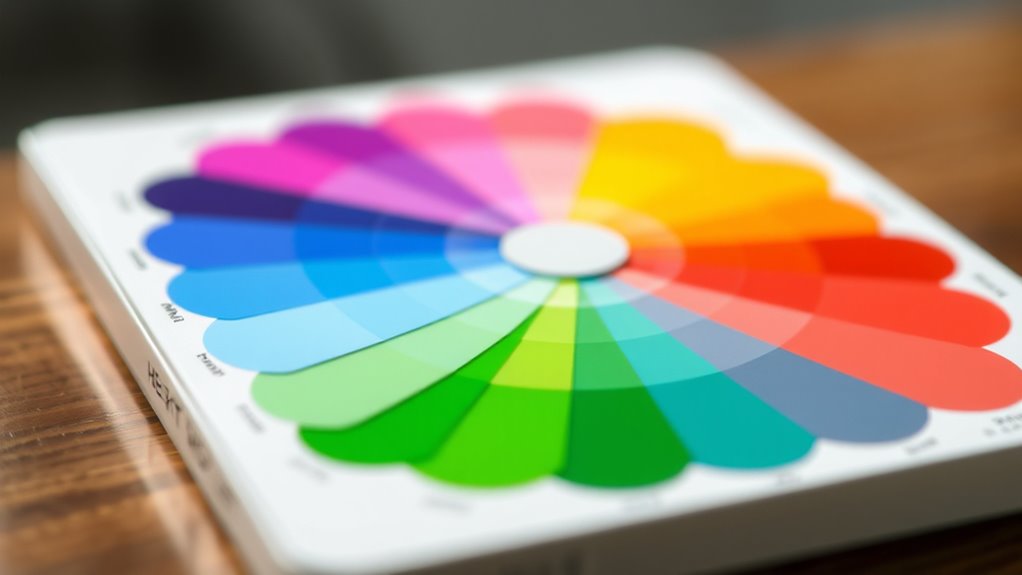
When selecting a Hue-Test color vision kit, I consider factors like test accuracy and how dependable the results are. I also look at whether the kit is suitable for different ages and skill levels, and how easy it is to use. Additionally, I evaluate the diagnostic features, portability, and storage options to ensure the kit meets my needs.
Test Accuracy and Reliability
Choosing a reliable hue-test color vision kit hinges on understanding several key factors that influence test accuracy. First, standardized testing procedures and well-calibrated equipment are essential to guarantee consistent results. Reliable kits should include validated scoring software that can accurately interpret subtle differences in color discrimination, reducing the chance of misdiagnosis. Consistency in lighting conditions during testing is critical; fluctuations can notably impact the accuracy of results. Additionally, the design and quality of the color reference caps directly affect the test’s ability to detect minor color vision deficiencies. Evidence-based validation studies further support the reliability of established hue-test kits, especially in clinical and occupational settings. Paying attention to these factors helps ensure you select a kit that provides precise and dependable assessments of your color vision.
Age and Skill Compatibility
Selecting a hue-test color vision kit that matches the user’s age and skill level is essential for obtaining accurate results. Younger children often need simplified or adapted tests to guarantee they can participate effectively. It’s also important to take into account whether the individual has the visual or cognitive skills necessary for the test, such as fine color discrimination. Many kits include instructions or features tailored for different skill levels, helping to prevent misinterpretation of results. When choosing a kit, opt for one that’s age-appropriate, considering age-related changes in color perception and visual acuity. Making sure the difficulty level aligns with the user’s abilities will produce more reliable and meaningful assessments, making the test both effective and appropriate for the individual.
Ease of Use Features
Ease of use is a crucial factor to contemplate because it directly affects how smoothly and accurately the test can be administered. I look for kits with clearly labeled, easily removable color caps to streamline the process and reduce errors. Simple scoring software or guides are essential, so I don’t need extensive training to interpret results. Ergonomic tray designs help me quickly and accurately place color samples during testing, saving time and minimizing mistakes. Intuitive instructions and minimal setup steps make the entire experience more user-friendly, especially if I’m not a professional. Additionally, having digital or printed guidelines ensures I can administer the test confidently, whether at home or in a clinical setting. Overall, these features make the testing process straightforward and reliable.
Diagnostic Capabilities Needed
When evaluating Hue-Test color vision kits, it’s important to take into account their diagnostic capabilities to guarantee they meet your specific needs. First, check if the kit can detect the particular color deficiencies you’re concerned about, like red-green or blue-yellow blindness. It’s also crucial that the kit can identify the severity and type of your color vision deficiency for more accurate assessment. Look for kits with extensive scoring and analysis software to interpret subtle hue differences effectively. Make sure the test includes a broad range of hues and incremental variations to evaluate your full spectrum of color perception. If you need precise diagnostics for clinical or occupational purposes, choose a kit validated for such use to ensure reliable, professional results.
Portability and Storage
A portable Hue-Test color vision kit should be lightweight and compact, making it simple to carry and set up in various environments. This guarantees you can perform tests on-site or in different locations without hassle. Sturdy, easy-to-clean storage cases are essential to protect the color caps and components from damage or contamination, preserving their accuracy. Modular tray systems help keep everything organized and allow quick access to reference caps during testing, saving time and reducing mistakes. Many portable kits feature foldable or pocket-sized designs, ideal for field use or quick setups. Clear labeling and well-defined compartments further enhance storage efficiency, minimizing the risk of misplacing or mixing colors. Overall, thoughtful portability and smart storage solutions make your testing experience smoother and more reliable.
Cost and Budget Constraints
Choosing a Hue-Test color vision kit requires careful consideration of your budget to guarantee you get the best value for your money. I recommend evaluating the overall cost in relation to your financial constraints to make sure of affordability. It’s essential to assess whether the kit offers the necessary features and accuracy for its price, maximizing your investment. Comparing prices across different brands or vendors can help you find a cost-effective option without sacrificing quality. Don’t forget to account for additional expenses like software, training, or replacement parts, which can impact the total cost. Ultimately, selecting a kit that fits within your budget while meeting your testing needs is key to making a smart, practical choice.
Certification and Standards
Ensuring your hue-test color vision kit meets established industry standards is essential for obtaining accurate and reliable results. Look for kits that comply with recognized standards like ISO 3664 or ANSI Z80.1, which ensure precise color matching and testing accuracy. Verify that the kit has certifications from reputable authorities or regulatory bodies, confirming its reliability and precision. It’s also important to check that all components, including color caps and software, are tested and certified for consistency across different batches. Validated through studies or accreditation processes, these kits demonstrate adherence to proven color vision testing protocols. Always choose products with clear documentation of their certifications and standards compliance, as this guarantees the validity of your test results and the overall credibility of your assessment.
Frequently Asked Questions
Can These Tests Detect Subtle or Partial Color Vision Deficiencies?
Yes, these tests can detect subtle or partial color vision deficiencies. I’ve found that high-quality Hue-Test kits are sensitive enough to identify even minor color perception issues, which might go unnoticed with less precise tools. They use detailed color plates and controlled lighting to reveal partial deficiencies, helping you understand your vision better. If you’re concerned about subtle issues, investing in a reliable hue test is definitely worth it.
How Often Should I Retake a Hue-Test for Accurate Monitoring?
I recommend retaking a hue-test every six months to keep an accurate eye on your color vision. Think of it as watering a plant—you need regular attention to notice changes. If you work with color-dependent tasks or notice any shifts, consider testing more frequently. Consistency helps track subtle differences over time, ensuring your color perception remains sharp. Regular testing becomes your personal color compass, guiding you through vibrant or muted days.
Are These Kits Suitable for Children or Only Adults?
These kits are generally designed for adults, but some child-friendly options exist. I recommend checking the age recommendations on each kit before purchasing. If you’re considering a kit for a child, look for one that’s simple, colorful, and easy to understand. Always supervise young children during the test to ensure they follow instructions correctly. If in doubt, consult an eye care professional for personalized advice.
Do These Tests Require Professional Administration for Accurate Results?
You might wonder if these tests need a professional to get accurate results. Honestly, they’re designed to be user-friendly, so you can often do them at home without needing a specialist. However, for the most precise and reliable results, especially if you suspect a serious color vision issue, consulting an eye care professional is a smart move. Trust me, a little guidance can make all the difference.
How Do Lighting Conditions Affect the Test Outcomes?
Lighting conditions definitely impact test results. I’ve found that bright, consistent lighting helps me see the colors clearly and avoid misinterpretation. Poor or uneven lighting can make it harder to distinguish subtle differences, leading to inaccurate results. I always guarantee the room is well-lit with natural or neutral white light before taking the test, so I get the most reliable outcome and an accurate assessment of my color vision.
Conclusion
So, whether you’re a modern-day color enthusiast or still marveling at the magic of the old Monty Hall, choosing the right hue-test kit is key. Remember, like the trusty sundial in a digital world, these tests help you see your true colors clearly. Pick one that suits your needs, and don’t delay—your perception of the world’s vibrant palette depends on it. After all, understanding color is timeless, just like a good ol’ pocket watch.
